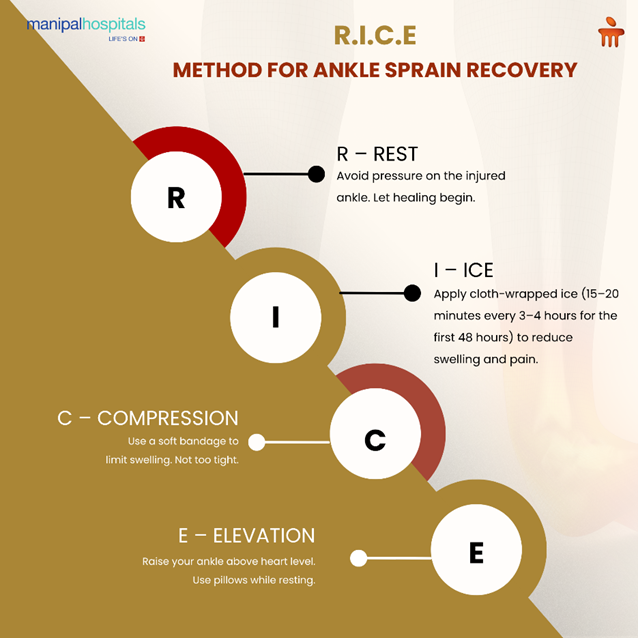
Did you injure your ankle while walking or playing a sport? Ankle sprains are more common than you might think, and many mild to moderate cases can be treated effectively at home. With proper care, most uncomplicated sprains heal without the need for medical intervention. In this blog, a top orthopaedist in Yeshwanthpur, Bengaluru, discusses how to manage a sprained ankle at home using simple, effective remedies.
Synopsis
Understanding Ankle Sprains
Ankle injury can occur through sports, a stumbling fall or sometimes when out for a walk. How do you figure out if it’s a big issue or not? Basic knowledge about ankle sprains lets you take care of the problem more quickly.
-
Twisting or Rolling Injury: Most of the time, an ankle sprain is caused by rolling or twisting your foot, forcing the ligaments in the ankle to stretch too far.
-
Swelling and Bruising: After a sprain, your injured tissues may swell and bruise in no time – make sure to keep an eye on these, as they are your body’s recovery sign.
-
Mild, Moderate, or Severe: Sprains can be classified as mild, moderate, or severe; a mild one just stretches the ligament, but a severe sprain might lead to partial or complete tearing and require more rest.
-
Pain When Moving or Standing: Joint or tendon pain when starting to move or stand is most likely a sprain, so follow the R.I.C.E. method for sprained ankle treatment immediately.
-
Ankle Feels Unstable: If your ankle becomes unstable during walking, this means the supporting tissues require extra help before you can try walking normally again.
-
Common in Sports and Everyday Life: People can get sprains when playing sports, dancing or walking, and sometimes it’s just from not thinking when rushing down the steps.
-
Healing Depends on Early Care: Following the advice early on gives your ankle the best chance to avoid stiffness and similar problems later on.
Home Remedies for Ankle Sprain Recovery
How to Treat an Ankle Sprain at Home?
Most ankle sprains, especially mild to moderate ones, can be safely treated at home. But are you following the right steps? Using simple, proven home remedies can make a significant difference in how quickly and effectively your ankle heals.
- R.I.C.E. Method:

-
Rest: Avoid putting weight on the injured ankle to prevent further strain.
-
Ice: Apply an ice pack wrapped in a cloth or plastic cover (15-20 minutes every 3-4 hours during the first 48 hours) to reduce swelling and pain.
-
Compression: Use an elastic bandage or compression wrap to help minimise swelling, but avoid wrapping it too tightly.
-
Elevation: Elevate the ankle above the level of your heart to reduce swelling. Use pillows to prop it up while lying down.
-
Over-the-Counter Pain Relievers: Nonsteroidal anti-inflammatory drugs (NSAIDs), such as ibuprofen or acetaminophen, can help reduce pain and inflammation. Always follow the recommended dosage and consult a doctor if you have any concerns or questions.
-
Use of a Supportive Brace or Wrap: A brace or ankle support can help stabilise the injured area, reduce pain, and prevent further injury during the healing process.
-
Gradual Weight-Bearing Exercises: As your ankle heals, gradually start to put more weight on it. Begin with walking short distances with gradual progression as tolerated.
When to See an Orthopaedic Specialist
While home care can work wonders for many ankle sprains, it’s important to know when to seek medical attention. Recognising the warning signs early can prevent prolonged discomfort and help you heal faster. Don’t try to just walk it off; read on to learn when it’s time to call in the experts.
-
Severe Swelling or Numbness: If your ankle swells rapidly or feels numb or cold, it may be more than a sprain and requires professional care immediately.
-
Inability to Bear Weight: If walking even a few steps is painful or impossible after 48 hours, it’s best to see an orthopaedic specialist in Yeshwanthpur.
-
Clicking or Popping Sounds: If you heard or felt a pop at the moment of injury, it could indicate a torn ligament or tendon. This isn't something home remedies can fix; it's a sign you should seek professional medical evaluation.
-
No Improvement After 3-4 Days: If swelling or pain doesn’t go down even after following the R.I.C.E. method, a doctor can check for hidden damage.
-
Recurring Ankle Sprains: If you keep twisting your ankle over and over, a specialist can suggest exercises, custom braces, or rehab for better long-term stability.
-
Visible Deformity or Bony Lump: If your ankle appears misshapen or you notice a hard lump forming, don’t delay; this could indicate a fracture rather than a simple sprain, and it requires immediate medical attention.
Conclusion
Spraining your ankle doesn’t always mean a trip to the hospital. With the R.I.C.E. method for sprained ankle treatment, over-the-counter meds, and proper support, you can bounce back faster than you think. Keep moving safely, and take those small steps back to recovery. If in doubt, reach out to an orthopaedic specialist in Yeshwanthpur for expert guidance and peace of mind.
FAQ's
Recovery time depends on the severity of the sprain. Mild sprains often improve within 1 to 2 weeks, while moderate ones can take 3 to 4 weeks. Be patient, give your body the rest it needs, and avoid putting weight on the ankle too soon. Healing takes time, but with the right care, you’ll get there.
You can wear a soft bandage or ankle brace during the day, especially when walking or doing light activities, to provide support and reduce swelling. However, be sure to remove it at night to allow your skin to breathe and avoid circulation issues. If the wrap feels too tight or causes tingling or numbness, loosen it immediately. Comfort and proper fit are essential for effective healing.
In the early days - no. You should rest and avoid putting weight on it. Once the pain and swelling go down, start strolling. Use support, such as a walker or brace, at first. Gradual movement is the secret to a quick recovery from an ankle sprain.
Not during the first 48 hours. In the early phase, ice is recommended to reduce swelling and inflammation. Once the swelling has subsided, typically after two days, you can apply heat. Warm compresses can help relax stiff muscles and improve blood flow, which aids in recovery.
If pain lasts more than a few days, or you can’t walk, it’s time. Also, if the ankle looks crooked, feels numb, or keeps spraining again and again, don’t wait. Connect with an orthopaedic specialist in Yeshwanthpur to rule out severe damage.





















 7 Min Read
7 Min Read










.png)








